
Water Softener Plant
We are providing Water Softener Plant that purifies the groundwater which contains a lot of dissolved rocks and minerals that releases calcium and magnesium ions which ultimately makes water hard. Hard water does not work up lather, thus it is not suitable for cleaning and bathing purposes. Water becomes hard when it has excessive levels of calcium and magnesium dissolved in it. Our Water Softener Plant is widely applied in boiler, cooling tower, air conditioning plant, textile processing, hospitals, hotels, laundries, etc. The Process of Water Softener Plant :The heart of a water softener is a mineral tank. It is filled with small polystyrene beads, also known as resin or zeolite. The beads carry a negative charge. Calcium and magnesium in water both carry positive charges. This means that these minerals will cling to the beads as the hard water passes through the mineral tank. Sodium ions also have positive charges, albeit not as strong as the charge on the calcium and magnesium. When a very strong brine solution is flushed through a tank that has beads already saturated with calcium and magnesium, the sheer volume of the sodium ions is enough to drive the calcium and magnesium ions off the beads. Water softeners have a separate brine tank that uses common salt to create this brine solution. In normal operation, hard water moves into the mineral tank and the calcium and magnesium ions move to the beads, replacing sodium ions. The sodium ions go into the water. Once the beads are saturated with calcium and magnesium, the unit enters a 3-phase regenerating cycle. First, the backwash phase reverses water flow to flush dirt out of the tank. In the recharge phase, the concentrated sodium-rich salt solution is carried from the brine tank through the mineral tank. The sodium collects on the beads, replacing the calcium and magnesium, which go down the drain. Once this phase is over, the mineral tank is flushed of excess brine and the brine tank is refilled. The water softeners use the well-proven “ion-exchange” process to convert the hard water ions of calcium and magnesium to sodium ions. Our Water Softener Plant is used to soften the water by removing the minerals that cause the water to be hard. Minerals like calcium and magnesium present in the water in their carbonates and bi-carbonates from makes water hard, which creates several problems when it is used in industrial as well as in other domestic purposes. Water softening plant uses ion-exchange process which relies on the replacement of the calcium and magnesium ions present in the water by an equivalent number of sodium ions. This eliminates the unwanted characteristics of hard water because the sodium salts never forms scale in any of the machinery parts. The resins get charged by sodium chloride solution (common salt), which is the cost effective and easiest maintenance process. We have designed highly efficient water softener to convert every type of hard water into soft water removing calcium, magnesium, sodium and ion from water.
...more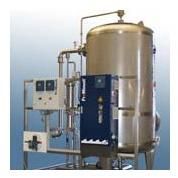
Ozonation Plant
We are offering Ozonation Plant for commercial, residential and industrial water treatment purposes. Application of Ozonation Plant ranges from treating swimming pool water to food processing water and bottling applications. Ozonation is a water treatment method that is tasked with killing bacteria and other microorganisms through an ozone infusion, which means exposing oxygen molecules to high electrical voltage creating a gas ozonation that claims many advantages such as providing extra barriers to public health, enhancing the quality of water, effectively kills viruses and bacteria, decreases the formation of chlorinated disinfection byproducts, enhances taste and odor control in water supply and optimal placement of ozone facilities reduces ozone dose and associated cost.Ozonation also has the power to eliminate solids from wastewater by oxidation and physical floatation, which increases pH and reduces color & turbidity. Ozonation is used by many applications such as drinking water treatment, swimming pools and beverage bottling companies. Ozonation has been found as an approved technology for drinking water treatment by the U.S. Environmental protection agency and has been extensively recognized as an effective method of treating drinking water to enhance taste and safety for municipalities, small communities and residences. This strong disinfectant has been approved for potable water treatment with strong capabilities of killing bacteria, viruses, giardia and cryptosporidium. Swimming pool owners have recognized the benefits of ozonation because it destroys bacteria, viruses and other water-borne contaminants up to 3100 times quicker than chlorine without generating any odor, burning eyes or hazardous by-products associated with harsh chemicals. Beverage bottling companies have been using ozonation as a residual disinfectant for bottled water from many years. Its sanitizing accomplishment has prompted the international bottled water association (IBWA) to require the use of ozonation in certain types of bottled water. Ozonation is used in the preparation of bottled water, surface sanitation, container rinsing and water preservation. Ozonation is also used in applications that include the removal of pesticide, organic and inorganic compounds, the improvement of the flocculation, coagulation, decantation process and the elimination of taste & odor.
...more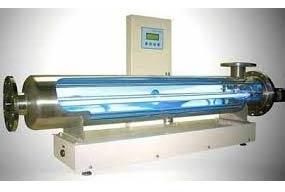
Ultraviolet Filtration System
Ultraviolet Filtration System that we offer is a safe, clean, easy-to-maintain method of assuring that water is free from bacteria. Ultraviolet Filtration System makes use of ultraviolet light, just like sunlight, to kill micro-organisms that may present in the water. It is a proven technology that has no significant drawbacks. In some applications, its initial cost can be a bit more than chlorination but because of its low operating cost it quickly pays for itself. It is environmentally friendly and essentially trouble-free. Most ultraviolet water treatment systems require only an annual change of lamp and a periodic change of the filter. Our Ultraviolet Filtration System can destroy 99.99 % of harmful micro-organisms without adding chemicals or changing the taste and color of water. It is one of the four methods of disinfection approved by the states FDA. UV has proven to be a quick, reliable and cost-effective method of disinfecting water.Advantages Of Ultraviolet Filtration System :For over 25 years, UV technology has been trusted as a safe, cost-effective way to purify water and eliminate harmful micro-organisms. It is a proven EPA endorsed technology that is currently being used by thousands of cities, bottled water manufacturers and homeowners around the world. UV provides water purification without the addition of harmful chemicals such as chlorine. It also avoids the potential of generating harmful chemical disinfection by products. Recent EPA guidelines are forcing cities across the United States to reduce or eliminate the use of chlorine owing to this reason. Ultraviolet Filtration System does not change the taste, odor or color of the water. Unlike chlorine, Ultraviolet Filtration System is more effective against both cryptosporidium and giardia. Further, Ultraviolet Filtration System is capable of treating a single faucet or an entire home in a minimum amount of space due to its compact design and the only maintenance being an annual lamp and filter replacements.
...more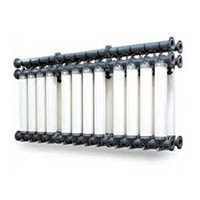
Ultra Filtration System
Ultra Filtration System is a kind of membrane filtration method. It is a filtration process which utilizes trans-membrane pressure differential to separate particles according to molecular weights. Ultrafiltration (uf) is a pressure-driven process that removes emulsified oils, metal hydroxides, colloids, emulsions, dispersed material, suspended solids and other large molecular weight materials from water and other solutions. Uf membranes are characterized by their molecular weight cut-off. Our Ultra Filtration System excels at the clarification of solution containing suspended solids, bacteria and high concentrations of macromolecules, including oil and water, fruit juice, milk and whey, electrocoat paints, pharmaceuticals, poly-vinyl alcohol and indigo, potable water and tertiary wastewater. Our Ultra Filtration System is applied in industrial process water, groundwater under the influence filtration, surface water filtration, municipal drinking water, reverse osmosis pretreatment and waste water treatment.
...more
String Wound Filter Cartridge
String Wound Filter Cartridge that we offer provides true depth filtration, high dirt holding capacity and extremely low media migration. Our String Wound Filter Cartridge is available in a wide variety of lengths and porosities. Especially significant is the availability of cartridge filters in an almost endless combination of media and core material, to handle virtually any condition related to chemical, environment or temperature. We offer cartridge filter in lengths of 10 inch, 20 inch, 30 inch and 40 inch. Our String Wound Filter Cartridge is extensively used for water, oils, concentrated alkalis, organic solvents, organic acids and photographical solution. The maximum operating temperature of our String Wound Filter Cartridge is : Polypropylene : 80oC (176oF) Glass Fibre : 400oC (752oF) Cotton : 160oC (320oF)
...more
Stainless Steel Filter Housings
We provide highly efficient Stainless Steel Filter Housings used for high flow applications. Constructed of 304L or 316L stainless steel with either a clamp or swing bolt-style closures, these Stainless Steel Filter Housings are the perfect choice for light duty as well as heavy duty industrial process. With flow rates that can exceed 1,000 GPM (3785 LPM), fittings that can be changed or moved to fit the specific needs and internals that can be made to accept the cartridge preference, these Stainless Steel Filter Housings have the flexibility to meet the client’s requirements. We provide Cartridge Filter Housing, Filter Housing, Multi Cartridge Filter Housing, Multi Round Filter Housing, and Multi Candle Filter Housing. Our Stainless Steel Filter Housings offer wide range of flow capacities & contaminant holding capacities. Cartridge filter is constructed of filter housing, filter cartridges, tube sheet, positive sealing arrangement for cartridge depending upon the type of cartridge & choice of end connections. Cartridge filter housing diameters can accommodate around 1 to 500 cartridges. Cartridge filters are normally used as polishing filter in almost all process industries. Positive sealing arrangement for cartridge filter assures no particle migration or fiber migration even after high differential pressures.
...more
Reverse Osmosis System
We are offering reverse osmosis system. principle of reverse osmosis system reverse osmosis (ro) is the process, in which water is pressurized through a semi –permeable membrane. As a result of this, as shown in the below depicted schematic diagram, water will pass through the membrane surface while the dissolved and particulate materials are left behind. When the pressure is applied to the concentrated solution, water is forced through the membrane from the concentrated side to the dilute side. This process is known as“ reverse osmosis.” reverse osmosis (ro) is a process of physical separation of dissolved solids and minerals present in water. This technology uses the principle of osmosis, wherein the mineral concentration of raw water is reduced by applying high pressure through a semi-permeable membrane. ro technology offers maximum flexibility to meet diverse requirements. Our customised software, landmark helps customers gain the maximum 'ro advantage', by helping to make the right selection. landmark considers your inlet water quality and capacity requirements and offers you optimised combination. This choice is dependent on different flux rates, pump models, membrane types and inlet water quality. It gives the right solutions, reduced what is reverse osmosis system? the reverse osmosis system is composed of two major parts, high pressure pump and the r.o. Membranes. The initial purified water production rate is measured at this pressure. it appears that there are long term benefits to be gained by operating at lower percent water recovery, particularly in reducing maintenance to the systems and minimizing precipitation problems which may arise due to operator error. it is important to realize that the purified water from a reverse osmosis system is delivered essentially at atmospheric pressure, usually to a vented storage tank. In general, it cannot be operated by opening and closing valve in the product water line (unless special pressure relief is provided). The reason for this is that the high pressure in the system drives the water across the membrane. And no flow of water would be possible if the pressure on both sides of the membranes were same. If, for some reason, the product water line is closed, while the system is operating, the pressure would build up. Of course, if the purified water side of the system was strong enough, the pressure would end up the same as the pump pressure, but at that point, no water would flow across the membrane. In reality, the p.v.c. Piping on the product water side normally would not tolerate such high pressure. the membrane is capable of taking 600 psi of “forward pressure”. I.e. From the direction of the supply water side to the purified water side. However, they are susceptible for it’s tolerance limit for “ back pressure.” i,e, from the direction of purified water side to the supply water side.” so, one should take care while operating the system. the quality of purified water produced by reverse osmosis process is roughly a constant percentage of the feed water. For example, if the feed water is entering at 50 ppm , the purified water may be about 1 to 2 ppm. (i.e. 96.00 to 98.00% rejection of dissolved minerals.). For another example, when the feed water is entering at 500 ppm, the purified water would be from 10 to 15 ppm. Usually a conductivity meter or tds meter is used to measure the mineral contents. the membrane based technology the application of reverse osmosis to the solution of problems in water treatment requires an understanding of the basic mechanisms involved in the process, the limitations of reverse osmosis and the pre treatment requirements. reverse osmosis utilizes the unique properties of a “imported” semi- permeable membrane to allow fluid to pass while restricting the flow of dissolved ionic material. With pressure applied to impure water on one side of such membrane materials, pure water will pass through, leaving most of the impurities behind. The rejection of the dissolved ionic material is a function of both molecular weight and ionic charge. For example, we can expect a nominal 90 % rejection of sodium chloride, which means that the product water passing through the membrane will have a concentration of salt approximately one-tenth that if the feed water. The rejection of calcium carbonate (hardness) will be nearly 95%. While most metallic salts will be rejected at a rate of 98% to 99%. the rejection of non- ionic or organic material is primarily done by mechanical filtration. advantages compact and modular ro blocks easy installation, operation and servicing specific selection possible from a wide range high level of plant automation visual monitoring system (vms) for ease of trouble-shooting stainless steel multistage centrifugal pump; inline suction and delivery allows easy maintenance and access online product water quality monitoring membrane and pump protection features minimum pipe length to reduce system resistance easy servicing with qrc (quick release coupling) material of construction: pvcss application ceramic chemicals dairy fishing food & beverages hospital hotel pharmaceutical pulp & paper textile
...more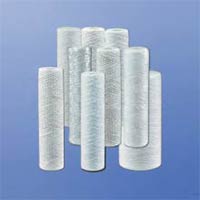
Polypropylene Spun Filter Cartridge
A melt blown process is used to create a solid matrix depth filter which traps particles throughout the cross section of the filter element. Its graded density pore structure traps larger particles in the outer layer and smaller particles in the inner layer. Polypropylene Spun Filter Cartridge that we offer is made up of 100 % polypropylene fibers. The fibers have been carefully spun together to form a true gradient density from outer to inner surface. Our Polypropylene Spun Filter Cartridge offers best performance as it has high dirt holding capacity and offer good flow. The Polypropylene Spun Filter Cartridge structure features excellent depth filtration due to good porosity. Polypropylene fibers sealed at fusing temperature ensuring no media migration. Also, graded pore structure gives longer service life. The maximum operating temperature of our Polypropylene Spun Filter Cartridge is 60°c and recommended charge out differential pressure is 35 psi. Polypropylene Spun Filter Cartridge is widely applied in water treatment industry, food & beverages industry, pharmaceutical industry, chemical industry, color & dyes industry, textile industry, edible oils, electronics, organic solvents, municipal, etc.
...more
Polypropylene Filter Housings
We are offering different types of Polypropylene Filter Housings made from 100 % virgin polypropylene, glass fiber, etc. Our Polypropylene Filter Housings are widely appreciated for their attributes like durability, molded construction, leak proof sealing, air release mechanism, etc. We provide these Polypropylene Filter Housings in different lengths like 5 inch, 10 inch, 20 inch, 30 inch, etc.
...more
Industrial RO system
Industrial RO System is the process, in which water is pressurized through a semi –permeable membrane. As a result of this, as shown in the below depicted schematic diagram, water will pass through the membrane surface while the dissolved and particulate materials are left behind. When the pressure is applied to the concentrated solution, water is forced through the membrane from the concentrated side to the dilute side. This process is known as“ Reverse Osmosis.”Reverse Osmosis (RO) is a process of physical separation of dissolved solids and minerals present in water. This technology uses the principle of osmosis, wherein the mineral concentration of raw water is reduced by applying high pressure through a semi-permeable membrane. RO technology offers maximum flexibility to meet diverse requirements. Our customised software, Landmark helps customers gain the maximum 'RO Advantage', by helping to make the right selection.Landmark considers your inlet water quality and capacity requirements and offers you optimised combination. This choice is dependent on different flux rates, pump models, membrane types and inlet water quality. It gives the right solutions, reduced What is Industrial RO System? The Industrial RO System is composed of two major parts, High Pressure pump and the R.O. membranes. The initial purified water production rate is measured at this pressure.It appears that there are long term benefits to be gained by operating at lower percent water recovery, particularly in reducing maintenance to the systems and minimizing precipitation problems which may arise due to operator error.It is important to realize that the purified water from a Reverse osmosis system is delivered essentially at Atmospheric pressure, usually to a vented storage tank. In general, It cannot be operated by opening and closing valve in the product water line (unless special pressure relief is provided). The reason for this is that the high pressure in the system drives the water across the membrane. And no flow of water would be possible if the pressure on both sides of the membranes were same. If, for some reason, the product water line is closed, while the system is operating, the pressure would build up. Of course, if the purified water side of the system was strong enough, the pressure would end up the same as the pump pressure, but at that point, no water would flow across the membrane. In reality, the P.V.C. piping on the product water side normally would not tolerate such high pressure.The membrane is capable of taking 600 psi of “forward pressure”. i.e. from the direction of the supply water side to the purified water side. However, they are susceptible for it’s tolerance limit for “ Back Pressure.” I,e, from the direction of purified water side to the supply water side.” So, one should take care while operating the system.The Quality of purified water produced by Reverse Osmosis process is roughly a constant percentage of the feed water. For example, if the feed water is entering at 50 ppm , the purified water may be about 1 to 2 ppm. (i.e. 96.00 to 98.00% rejection of dissolved minerals.). For another example, when the feed water is entering at 500 ppm, the purified water would be from 10 to 15 ppm. Usually a Conductivity meter Or TDS meter is used to measure the mineral contents. The Membrane Based Technology The application of Reverse Osmosis to the solution of problems in water treatment requires an understanding of the basic mechanisms involved in the process, the limitations of reverse osmosis and the pre treatment requirements. Reverse osmosis utilizes the unique properties of a “Imported” semi- permeable membrane to allow fluid to pass while restricting the flow of Dissolved Ionic material. With pressure applied to impure water on one side of such membrane materials, pure water will pass through, leaving most of the impurities behind. The rejection of the dissolved ionic material is a function of both Molecular weight and Ionic charge. For example, we can expect a nominal 90 % rejection of Sodium Chloride, which means that the product water passing through the membrane will have a concentration of salt approximately One-tenth that if the feed water. The rejection of calcium carbonate (Hardness) will be nearly 95%. While most metallic salts will be rejected at a rate of 98% to 99%. The rejection of non- ionic or organic material is primarily done by mechanical filtration. Advantages Compact and modular RO blocks Easy installation, operation and servicing Specific selection possible from a wide range High level of plant automation Visual monitoring system (VMS) for ease of trouble-shooting Stainless steel multistage centrifugal pump; inline suction and delivery allows easy maintenance and access Online product water quality monitoring Membrane and pump protection features Minimum pipe length to reduce system resistance Easy servicing with QRC (Quick Release Coupling) Material of construction : PVC/SS Applications Ceramic Chemicals Dairy Fishing Food & Beverages Hospital Hotel Pharmaceutical Pulp & Paper Textile Technical Details : filtering capacity-500-10,000 lph
...more
Domestic RO System
We bring forth a wide range of Domestic RO System that is widely installed in residences for the purpose of acquiring purified drinking water. Our range includes Dolphin Domestic R.O.System, Crystal Domestic R.O.System, Kent Domestic R.O.System and P-Top Domestic R.O.System. Our Domestic RO System purifies water through different stages of filtration, which removes all the impurities such as dust, mud, germ and other contaminants from the water. Also, Domestic RO System removes different microbiological impurities like viruses and bacteria that may cause various ailments such as high-blood pressure, kidney stones, indigestion and gastric bacterial diseases.
...more
Demineralised Plant
We are offering Demineralised Plant that is also called as DM plant in water treatment division. This water treatment system is used for removing unnecessary minerals salts from water. The system uses on ion exchange process for eliminating minerals, calcium, iron, copper and cat ions of sodium like mineral ions as well as anions like sulphate, chloride, nitrate that exists in the normal water. Our Demineralised Plant generates mineral free water. The demineralization technology is one of the established processes of water treatment. Our Demineralised Plant is widely applied in food & beverages industries, oil & gas industries, chemical industries, power plants, fabric industries and pharmaceuticals industries. Our Demineralised Plant consists of two pressure vessels containing cation and anion exchange resins. Various types of ion exchange resins can be used for both the cation and the anoin process depending on the type of impurities in the water and on the fact that what will be the usage of final water. Typically, the cation resin operates in the hydrogen cycle. The cation in the water (i.e. Calcium, magnesium and sodium) passes through the cation exchange resin where they are chemically exchanged for hydrogen ions.The water then passes through the anion exchange resin where the anions (i.e. Chloride, sulphate, nitrate and bicarbonate) are chemically exchanged for hydroxide ions. The final water from this process consists essentially of hydrogen ions and hydroxide ions, which is the chemical composition of pure water. The simplified demineralization plant consists of composite resin vessel with change of composite resin vessel and change of strong cation & anion resin, control panel encompassing conductivity measurement and alarms, etc. Deionizer Types : There are two types of demineralization plant, two-bed and mixed-bed. A two-bed system employs separate cation and anion resin beds. Mixed-bed deionizers utilize both resins in the same vessel. The highest quality water is produced by mixed-bed deionizers, while two-bed deionizers have a larger capacity. All Demineralised Plant will eventually be exhausted from use. To regenerate the resin and increase the dm plant efficiency, it is regenerated. The regeneration process is slightly different for a mixed-bed dm plant compared to the two-bed dm plant. Two Bed DM Plants :This process first exchanges the cations of the salts for the hydrogen ions and then exchanges the anions of the salts for the hydroxide ions. A dm plant consists of two pressure vessels containing cation and anion exchange resins. Various types of ion exchange resin can be used for the cation and the anion process, depending on the type of impurities in water and what the final water is used for. Sizes of dm plants vary from compact trolley mounted to bigger one.A two-bed dm plant contains either cation or anion resin beads. In most cases, there are two, single-bed ion exchangers in series. The first is a cation bed and the second is an anion bed. Impurities in plant water are replaced with hydrogen ions in the cation bed and hydroxyl ions in the anion bed. The hydrogen ions and the hydroxyl ions then combine to form pure water. Mixed Bed Dm Plants : A mixed-bed dm plant is a dm plant in which the cation and anion resin beds are mixed together. In effect, it is equivalent to a number of two-steps dm plant in series. In a mixed-bed dm plant, more impurities are replaced by hydrogen and hydroxyl ions and the water that is produced is extremely pure. The conductivity of this water can often be less than 0.06 microns per centimeter.
...more
Commercial Ro System
Commercial RO System is widely used in commercial sector in order to purify water while improving its taste and removing all impurities. Our Commercial RO System is available in different specifications. Our range is also integrate with 0.0001 micron capillaries, which remove dissolved ( salts, heavy metals and soluble impurities ) as well as suspended impurities ( bacteria, viruses, sediments and dirt ) from the water. To make water free & safe from biological impurities and remove total dissolved solids (TDS) up to 90 to 98 %, we make use of special membranes. Major applications of Commercial RO System includes offices, showrooms, shopping-malls, hotels, pubs, restaurants, schools, educational institutes, universities, clinics, hospitals, health-clubs, farm houses, factories, etc.
...more
Bag Filter Assembly
Bag Filter Assembly is widely installed in various types of water purification units to facilitate hygienic and easy cleaning. Our Bag Filter Assembly has a capacity to filter dirt, dust and many other particles in order to clean the water. Bag Filter Assembly that we offer gets easily fit in filter and increases its functional life. Our Bag Filter Assembly is widely applied in industries like sugar, pharmaceuticals, beverages, dairy, water treatment, thermal power plant, oil refinery, etc.
...more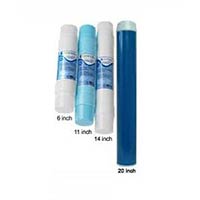
Alkaline PH Filter
Alkaline PH Filter that we offer is a high capacity, effective PH increaser that produces alkaline drinking water. Our Alkaline PH Filter is constructed from NSF certified ceramic materials which has a special formation of PH increasing minerals including calcium, magnesium, potassium and sodium to make water more alkaline for increased energy and good health. Our Alkaline PH Filter is available in different lengths like 6 inch, 11inch, 14 inch, 20 inch, etc.The filtered water can be measured with a PH or ORP meter and its redox (oxidation reduction potential) is + 400 to + 500 mV. Because it has a positive redox potential, it is apt to acquire electrons and oxidize other molecules. Reduced Ionized water, on the other hand, has a negative redox potential of approximately – 250 to – 800 mV. This means it has large macs of electrons ready to donate to electron thieving active oxygen. It is “Live-water”, similar in atomic structure to the water that the Hunzakuts drink directly from glacial streams in the high Himalayas. Importance of Alkaline Water :Water transports oxygen and nutrients throughout the body, removes waste and maintains proper communication between the body’s living cells. Water detoxifies by flushing out the body’s waste. Our body is alkaline and functions best in an alkaline environment. However, everyday a human body creates acid, digestion, respiration and stress, which all generate acid and acidic by-products.By drinking alkaline water, we increase the intake of oxygen and help neutralize the build-up of acids before they get stored in the body. Acid coagulates blood causing bad circulation. An abundance of alkaline water promotes better blood circulation while eliminating acidic waste that helps the body in getting healed itself. Alkaline water helps rid acidic waste making them more soluble in the blood. Thus, acidic wastes will be easily drained from the body in the form of urine and sweat.PH is a factor that has a vital effect on the blood’s capacity to uptake, carry and delivers oxygen to all parts of the body. Blood PH is highest just after it leaves the lungs, around 7.6 and lowest just before it returns to the lungs at 7.3 or a little less. Benefits of Drinking Alkaline Water : Human bodies should have a blood PH value of 7.36 to 7.44. Consumption of meats, dairy, coffee & processed sugars creates acidic ash in the body. Even the water we drink can be acidic adding to the body’s attempts to maintain its naturals PH value. The benefit of drinking alkaline water is that it helps the body maintain its PH balance. Our body can go out of balance because we consume food and water that has a high acid content. Alkanity can be increased by consuming less meat and sweets and more vegetables & fruits.
...more
cartridge bag filter

RO System
Be first to Rate
Rate ThisOpening Hours